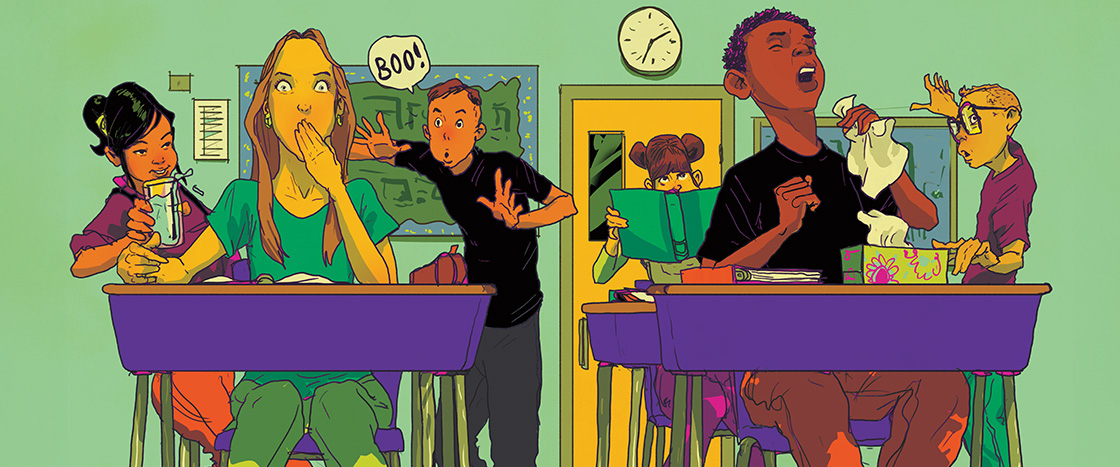A lightning-quick jerk of your chest. Hiccup! An annoying tickle in your nose. Ah . . . Ahh . . . ! Usually, these uncomfortable sensations don’t last very long. But what if they never went away? Between constant hiccups and always needing to sneeze, which do you think you could handle?

Would You Rather Have Hiccups Forever or Always Be About to Sneeze?
Which condition do you think you could handle?
Learning Objective: Students will gather and use information about hiccups and sneezing to support an argument.
HICCUPS FOREVER
Shutterstock.com (Background); iStockPhoto/Getty Images (Hiccuping Child)
On average, hiccups last 5 minutes. Persistent hiccups, a rare condition, can last longer than 48 hours!
WHAT IT WOULD BE LIKE
via Newspaper.com
Charles Osborne
Most of the time, hiccups stop after a few minutes. But there is one person whose hiccups lasted much longer—68 years! In Iowa in 1922, Charles Osborne began hiccuping after a serious injury. No treatment helped. He learned to breathe and speak differently to reduce the constant hic sound. He couldn’t swallow solid food, so he drank his meals through a straw. His chest was always sore. That’s what having hiccups forever would probably be like!
HOW HICCUPS HAPPEN
When you take a breath, a muscle below your lungs called the diaphragm (DYE-uh-fram) squeezes down and flattens. This lets air into your lungs. Hiccups start when your diaphragm squeezes so quickly your chest jerks. To stop unwanted air from coming in, your vocal cords snap shut with a familiar sound—hiccup!
TYPICAL CAUSES
Hiccups happen when something bothers your lungs, throat, or gut—which affects your diaphragm. Spicy foods and fizzy drinks are top offenders. If you eat too fast, you might gulp down air. That increases your hiccup risk too!
POSSIBLE CURES
To stop hiccups, you need to relax your diaphragm. One way to do that? Distract your brain! Drink a tall glass of water. Hold your breath. Have someone scare you! All of these actions force your brain to use your breathing muscles differently, making those hiccups go away.
ALWAYS BE ABOUT TO SNEEZE
Shutterstock.com (Background); Comstock Images/Getty Images (Sneezing Child)
Ah . . . CHOO! During a sneeze, air bursts from your nose at about
100 miles (161 kilometers) per hour!
WHAT IT WOULD BE LIKE
iStockPhoto/Getty Images
Neti pot
You’ve probably felt like you were about to sneeze before . . . only to have nothing happen! The tickle in your nose becomes a burning sensation. Your eyes water. It would feel awful to experience that all the time. But worse than that? You would never sneeze! Dust, pollen, and germs would collect in your nose. You would get sick more often. If you have allergies, your symptoms would get even worse. You might even need to use a special device to rinse the irritating particles from your nose with salt water every day!
HOW SNEEZES HAPPEN
The air you breathe is full of tiny particles. Certain irritating ones tickle your nose, sending a message to your brain to get rid of them. Your brain tells muscles in your torso to squeeze hard. The result? A powerful, cleansing sneeze!
TYPICAL CAUSES
The most common tickle-causing particles are dust, pollen, and germs. It’s always important to sneeze into your elbow or a tissue. That way germs that shoot out don’t infect someone else!
POSSIBLE CURES
Often a sneeze is all it takes to stop that tickling sensation. Try smelling a bit of black pepper. Those extra, annoying particles could be enough to push a sneeze over the edge.
Which would you rather have?
Which would you rather have?
Which would you rather have?
1. PREPARE TO READ (10 minutes)
Make an initial choice and explain the reasoning behind it.
- If needed, explain the “Would You Rather . . . ?” game. In this game, a person must make a tricky choice between two things. There isn’t a “right” answer, but you must choose one and then defend your choice.
- Project the opening pages of the article, reading the captions aloud.
- ASK: Would you rather have hiccups forever or always be about to sneeze? Let students record their initial choice and quickly jot down the reasoning behind their decision.
2. READ AND evaluate (20 minutes)
Gather information and discuss text evidence.
- Play the video “Would You Rather Have Hiccups Forever or Always Be About to Sneeze?” Give students time to change their choice and/or add any new information from the video to their reasoning.
- Designate one side of the room “hiccups forever” and the other side “always about to sneeze.” Tell students they’re allowed to change their mind later, but for now they should go to the side that matches their choice. Do a quick tally of each side and record it on the board. Then have students return to their seats.
- Read the article aloud or have students read it independently. Compare sections with the same titles, like “Typical Causes” and “Possible Cures.”
- ASK: What information did you find most surprising or interesting? (e.g., During a sneeze, air bursts from your nose at about 100 miles per hour!) Tell students to discuss in small groups. Then ask for volunteers to share their responses with the class.
- ASK: Did your original choice change? If so, why? Remind students that new information can change one’s mind—and that’s OK! As we learn more, our thinking often changes.
3. RESPOND TO READING (15 minutes)
Write and evaluate an evidence-based opinion.
